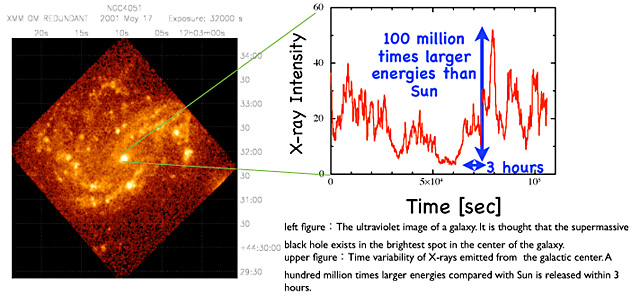A black hole, predicted by Einstein's theory of relativity, is a theoretical monster. Even light cannot escape from it, and thus it is literally the darkest body in the universe. The massive gravity of a black hole distorts the surrounding spacetime and gives rise to interesting physics phenomena that cannot be realized on Earth. Therefore, black holes can serve as highly important natural experimental fields to confirm fundamental laws of physics such as the general theory of relativity. Black holes not only absorb matter but also expel high-speed jets, which are often observed. The speed of these jets can sometimes exceed 90% of the speed of light, and thus they have attracted attention as potential natural particle accelerators. In addition to stellar mass black holes and massive black holes, candidates for a new type of black holes termed intermediate mass black holes have been recently discovered, allowing us to clarify the growth of black holes. Furthermore, recent observations have revealed that the growth (evolution) of black holes is closely related to the evolution of galaxies, and thereby black holes are thought to be the most important research subject in understanding the 13.7-billion years of growth of the universe.
In the Division of Origin of Spacetime Structures we are unraveling various aspects of these dark bodies in terms of both observation and theory. X-ray observation using flying objects plays a central role in detecting X-rays emitted by matter just before it is absorbed by a black hole. X-ray intensity variations and X-ray spectral information are used to extract physical quantities such as the spin of black holes, the state of motion of matter near black holes, and the flow of matter into black holes. All of these phenomena are directly related to the elucidation of the spacetime structure and growth mechanisms of black holes. The acceleration mechanisms of particles near black holes will be clarified by combining observational data obtained by radio waves and γ-rays with those obtained by X-rays. Moreover, we perform a theoretical examination of the fundamental mechanisms of energy extraction from black holes (Penrose process, superradiance and the structure of black hole magnetospheres) to enhance the understanding of black holes as a driving force of high-energy cosmological phenomena. Theoretical understanding of high-energy cosmological phenomena is also pursued by visualizing spacetime near black holes and constructing theoretical models of the intensity variations and spectra of X-ray sources. At the same time, as a tangent to actual cosmological phenomena, research on pseudo-black holes using a fluid system is conducted to investigate the possibility of black-hole evaporation in the laboratory.


